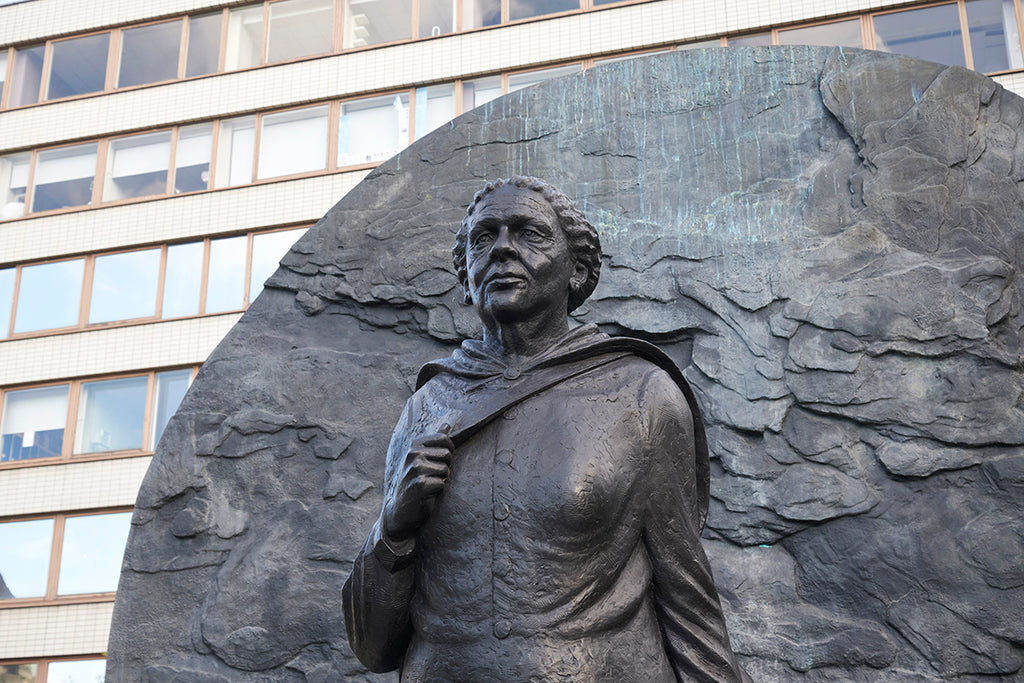Our new Women’s History London Map highlights statues, sculptures, blue plaques, gravestones, buildings and monuments dedicated to important and impactful women such as Millicent Garrett Fawcett, Virginia Woolf, Aphra Behn, Ada Lovelace and Phillis Wheatley. With an introduction by Katie Wignall, author, tour guide and Londoner, and photography by Jo Underhill, the map seeks to reframe the well-trodden routes and perspectives of history as we know it.
It may come as a surprise, but in London statues, plaques and memorials of women are few and far between. In 2021 a study by Art UK showed women account for just 15% of statues of named people in the city; and across all public sculpture, only 4% are of named women (compared to 8% depicting animals!). All of which makes this map’s mission to document, highlight and celebrate women’s history an important one.
If you know where to look, we are surrounded by reminders of inspiring women who challenged the status quo and made an impact across a breadth of fields. They can be found in street names, on plaques and even in gardens, covering a vast period from Boudicca (c.30–61 AD) to artist Tracey Emin (b.1963) and spanning all kinds of professions from literature (Agatha Christie, Charlotte Brontë, Virginia Woolf ) to politics (Elizabeth Garrett Anderson, Claudia Jones) to health (Edith Cavell) and technology (Ada Lovelace).
Violette Szabo's bust on Lambeth Palace Road, London
The women’s suffrage movement in Britain is a key period in history represented in the city and illustrated by this map. From strategic organisational buildings such as Caxton Hall and Conway Hall; to the statue of Millicent Garrett Fawcett in Parliament Square situated on a base scribed with the names and photographs of 59 key women’s suffrage activists; a clock commemorating heroic East London suffragette and Poplar councillor Minnie Lansbury; and statues of Emmeline Pankhurst and Mary Wollstonecraft and street art of Sylvia Pankhurst.
Yet there are many histories that are less represented and also of course missing. From Mary Seacole, Jamaican-born nurse and businesswoman, to Emma Clarke, Britain's first Black female football player, each woman on the map not only merits inclusion in their own right, yet also represents women's histories that have been overlooked and other women who have come before and after them.

Statue of Mary Seacole near Westminster Bridge in London
Though they may not be represented by statues, many women are hiding across London in plain sight. The Southbank Lion on Westminster Bridge is one of over 650 examples of Coade Stone to be found; the material is actually an early cement recipe (a guarded secret until the 1980s), named after its pioneer, the 18th century’s most savvy businesswoman Eleanor Coade. Another example is Meath Gardens in Bethnal Green, one of 75 gardens designed by Fanny Wilkinson, honorary landscape gardener to the Metropolitan Public Gardens in 1884 and first female principal of Swanley Horticultural College.
All of the women highlighted on this map are pioneers in their respective fields, yet undoubtedly you’ll be sure to learn something new. We hope this map contributes to reframing the well-trodden routes and perspectives of history as we know it. In this spirit, we encourage you to continue to seek and uncover the many other lesser and unknown histories along the way.

Women's History London Map is available in bookstores and from our website here.

